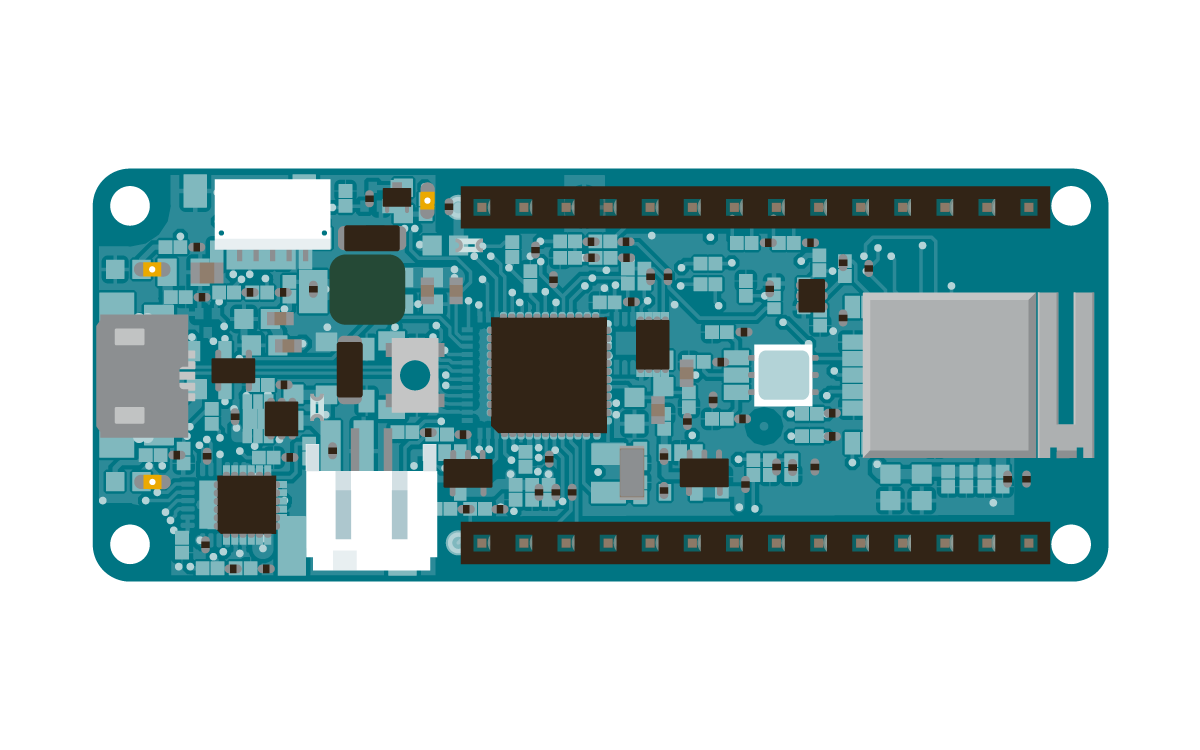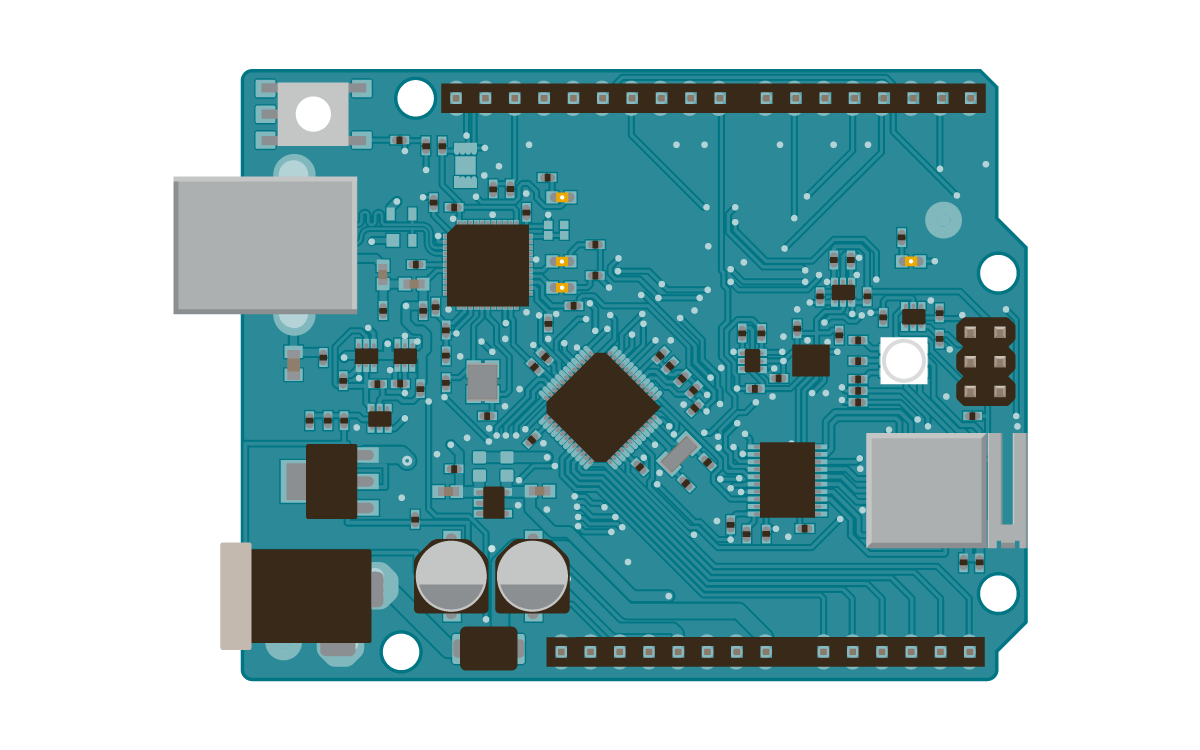Connect With WEP
This example shows you how to connect to a WEP encrypted 802.11b/g network with one of the boards that support this library. Your Arduino Software (IDE) serial monitor will provide information about the connection once it has connected.
Hardware Required
Circuit
The WiFi module is integrated on your board and you don't need any special circuitry to get this tutorial to work.
Please note: these three boards use dedicated pins to communicate and select the WiFi module, therefore you have no restriction in the usage of the available digital pins connected to the header pins.
Code
You should have access to a 802.11b/g wireless network that connects to the internet for this example. You will need to change the network settings in the sketch to correspond to your particular networks SSID.
WEP network passwords are hexadecimal strings known as keys. A WEP network can have 4 different keys; each key is assigned a "Key Index" value. For WEP encrypted networks, you need the SSID, the key, and key number.
This example connects to a WEP-encrypted Wifi network.
Then it prints the MAC address of the Wifi module,
the IP address obtained, and other network details.
If you use 40-bit WEP, you need a key that is 10 characters long,
and the characters must be hexadecimal (0-9 or A-F).
e.g. for 40-bit, ABBADEAF01 will work, but ABBADEAF won't work
(too short) and ABBAISDEAF won't work (I and S are not
hexadecimal characters).
For 128-bit, you need a string that is 26 characters long.
D0D0DEADF00DABBADEAFBEADED will work because it's 26 characters,
all in the 0-9, A-F range.
created 13 July 2010
by dlf (Metodo2 srl)
modified 31 May 2012
by Tom Igoe
*/
#include <SPI.h>
#include <WiFiNINA.h>
#include "arduino_secrets.h"
///////please enter your sensitive data in the Secret tab/arduino_secrets.h
char ssid[] = SECRET_SSID; // your network SSID (name)
char pass[] = SECRET_PASS; // your network password (use for WPA, or use as key for WEP)
int keyIndex = 0; // your network key Index number
int status = WL_IDLE_STATUS; // the Wifi radio's status
void setup() {
//Initialize serial and wait for port to open:
Serial.begin(9600);
while (!Serial) {
; // wait for serial port to connect. Needed for native USB port only
}
// check for the WiFi module:
if (WiFi.status() == WL_NO_MODULE) {
Serial.println("Communication with WiFi module failed!");
// don't continue
while (true);
}
String fv = WiFi.firmwareVersion();
if (fv < "1.0.0") {
Serial.println("Please upgrade the firmware");
}
// attempt to connect to Wifi network:
while (status != WL_CONNECTED) {
Serial.print("Attempting to connect to WEP network, SSID: ");
Serial.println(ssid);
status = WiFi.begin(ssid, keyIndex, pass);
// wait 10 seconds for connection:
delay(10000);
}
// once you are connected :
Serial.print("You're connected to the network");
printCurrentNet();
printWifiData();
}
void loop() {
// check the network connection once every 10 seconds:
delay(10000);
printCurrentNet();
}
void printWifiData() {
// print your board's IP address:
IPAddress ip = WiFi.localIP();
Serial.print("IP Address: ");
Serial.println(ip);
Serial.println(ip);
// print your MAC address:
byte mac[6];
WiFi.macAddress(mac);
Serial.print("MAC address: ");
printMacAddress(mac);
}
void printCurrentNet() {
// print the SSID of the network you're attached to:
Serial.print("SSID: ");
Serial.println(WiFi.SSID());
// print the MAC address of the router you're attached to:
byte bssid[6];
WiFi.BSSID(bssid);
Serial.print("BSSID: ");
printMacAddress(bssid);
// print the received signal strength:
long rssi = WiFi.RSSI();
Serial.print("signal strength (RSSI):");
Serial.println(rssi);
// print the encryption type:
byte encryption = WiFi.encryptionType();
Serial.print("Encryption Type:");
Serial.println(encryption, HEX);
Serial.println();
}
void printMacAddress(byte mac[]) {
for (int i = 5; i >= 0; i--) {
if (mac[i] < 16) {
Serial.print("0");
}
Serial.print(mac[i], HEX);
if (i > 0) {
Serial.print(":");
}
}
Serial.println();
}
See Also:
- WiFi NINA library – Your reference for the WiFi NINA Library.
- Arduino MKR WiFi 1010 – Product details for the Arduino MKR WiFi 1010 board.
- Arduino MKR VIDOR 4000 – Product details for the Arduino MKR VIDOR 4000 board.
- Arduino UNO WiFi Rev.2 – Product details for the Arduino UNO WiFi Rev.2 board.
- AP_SimpleWebServer : A simple web server to manage a LED with AP feature
- ConnectNoEncryption : Demonstrates how to connect to an open network
- ConnectWithWPA : Demonstrates how to connect to a network that is encrypted with WPA2 Personal
- ScanNetworks : Displays all WiFi networks in range
- ScanNetworksAdwanced : Displays all WiFi networks, also the encrypted ones, in range
- SimpleWebServerWiFi : A simple web server to manage a LED
- WiFiChatServer : Set up a simple chat server
- WiFiPing : Demonstrates how to ping a website or IP address
- WiFiSSLClient : Connect to a website using SSL
- UdpNTPClient : Query a Network Time Protocol (NTP) server using UDP
- WiFiUdpSendReceiveString : Send and receive a UDP string
- WiFiWebClient : Connect to a remote webserver
- WiFiWebClientRepeating : Make repeated HTTP calls to a webserver
- WiFiWebServer : Serve a webpage from the WiFi module
Last revision 2018/07/12 by SM



